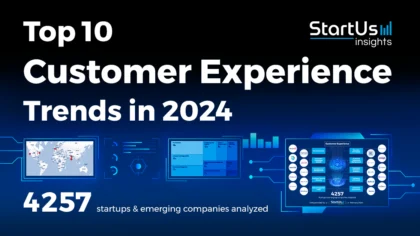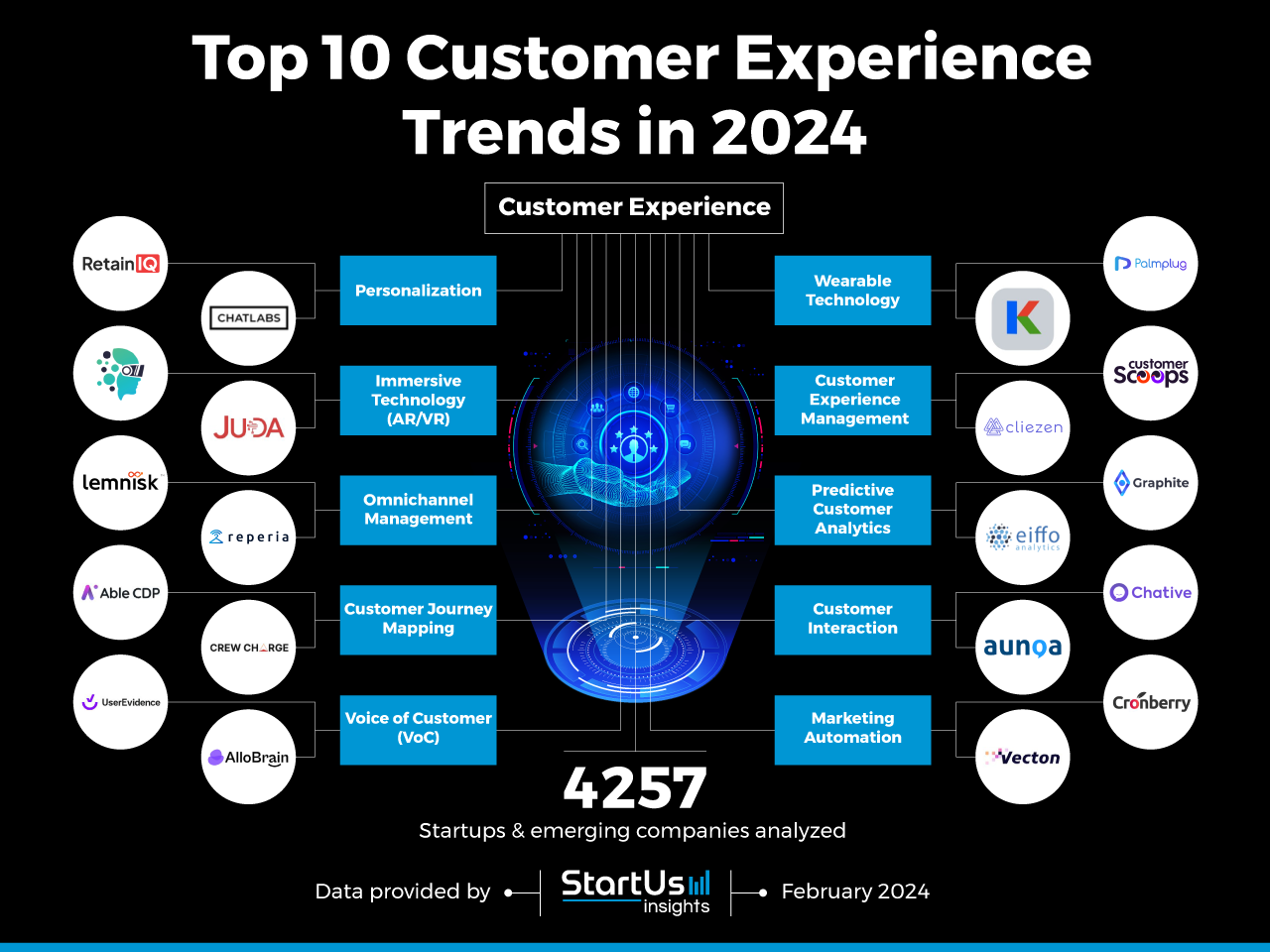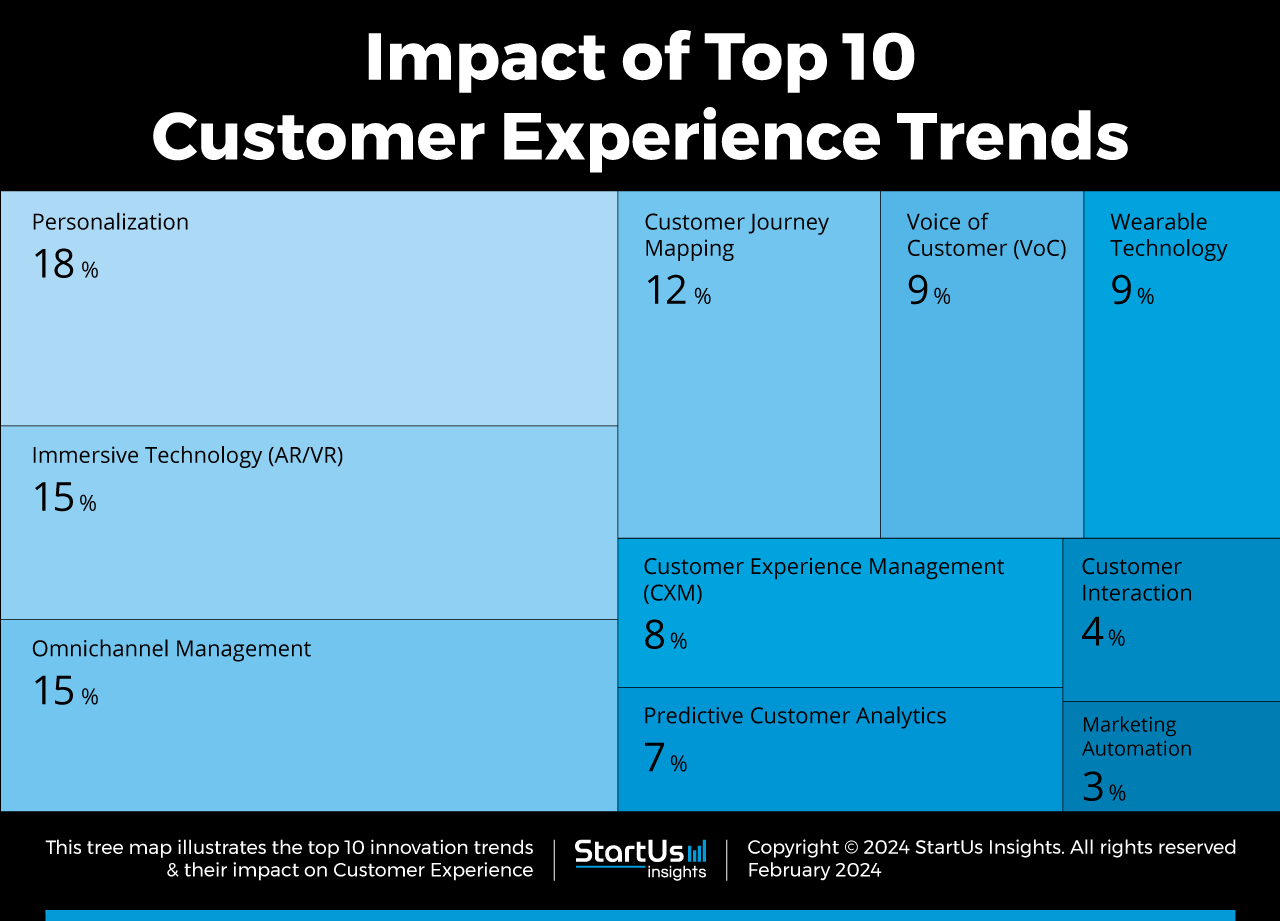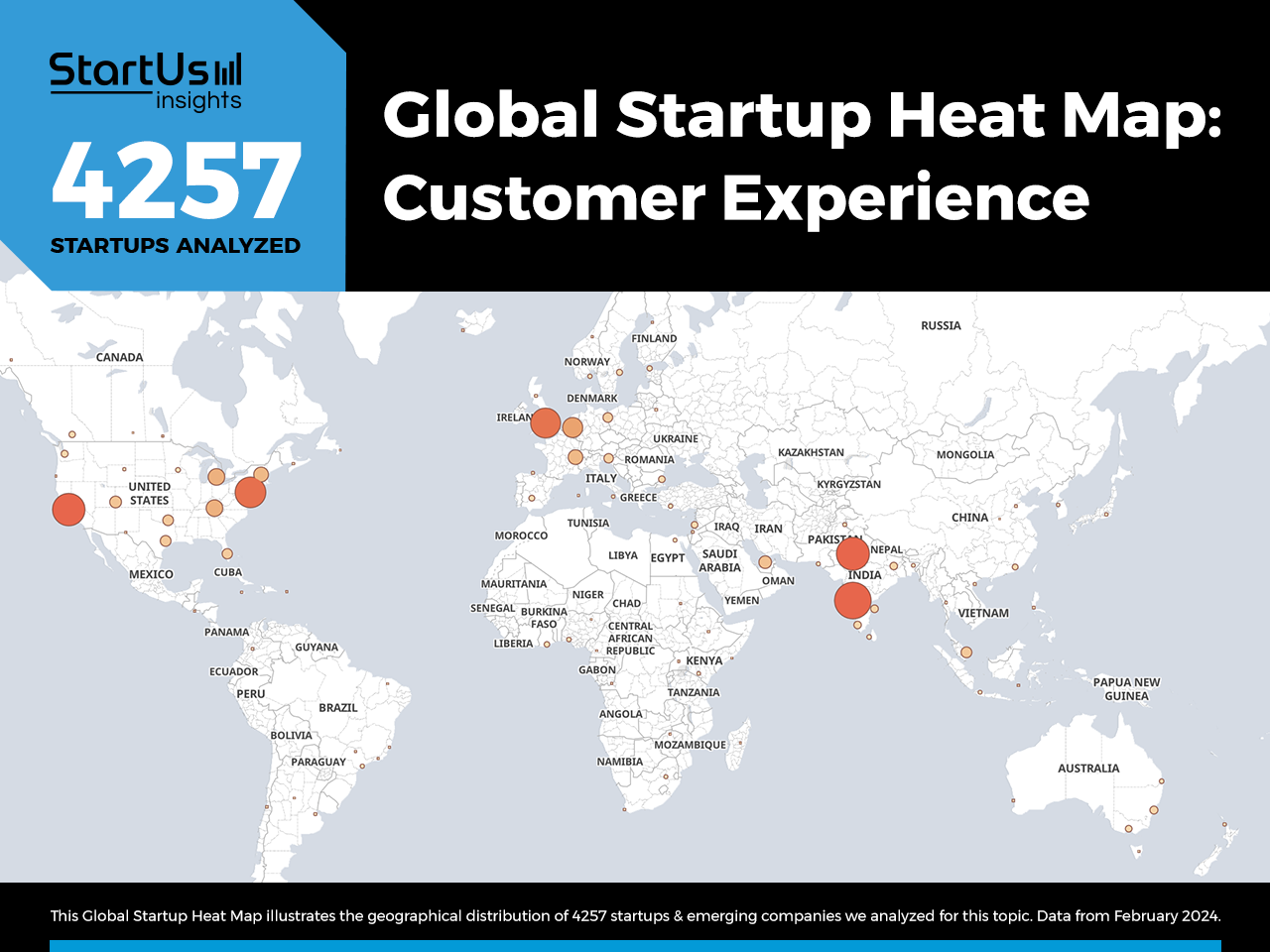In today’s market, a standout customer experience (CX) sets brands apart. As choices proliferate, CX goes beyond product quality. It encompasses the full journey from brand interaction to post-purchase support. Innovations like augmented or virtual reality (AR/VR) and wearable technology elevate this journey to deliver personalized, immersive experiences that foster long-term loyalty.
Modern CX management also demands a deep understanding of evolving customer behaviors influenced by external forces. Industries thus integrate omnichannel services for a more personalized touch and employ creative, technology-led strategies to simplify and enhance customer interactions. Aligning brand promises with customer values, companies also secure growth and relevance in a rapidly changing consumer landscape.
Top 10 Trends in Customer Experience (2024)
- Personalization
- Immersive Technology (AR/VR)
- Omnichannel Management
- Customer Journey Mapping
- Voice of Customer (VoC)
- Wearable Technology
- Customer Experience Management (CXM)
- Predictive Customer Analytics
- Customer Interaction
- Marketing Automation
Innovation Map outlines the Top 10 Customer Experience Trends & 20 Promising Startups
For this in-depth research on the Top Customer Experience Trends & Startups, we analyzed a sample of 4257 global startups & scaleups. This data-driven research provides innovation intelligence that helps you improve strategic decision-making by giving you an overview of emerging technologies in customer-centric industries. In the Customer Experience Innovation Map, you get a comprehensive overview of the innovation trends & startups that impact your company.
These insights are derived by working with our Big Data & Artificial Intelligence-powered StartUs Insights Discovery Platform, covering 4 760 120+ startups & scaleups globally. As the world’s largest resource for data on emerging companies, the SaaS platform enables you to identify relevant technologies and industry trends quickly & exhaustively.
Tree Map reveals the Impact of the Top 10 Customer Experience Trends in 2024
Based on the Customer Experience Innovation Map, the Tree Map below illustrates the impact of the Top 10 Customer Experience Management Trends in 2024. Personalization offers bespoke experiences while AR and VR technologies create immersive environments. Omnichannel approaches ensure consistent experiences across diverse platforms, guided by insights from detailed customer journey mapping.
Further, the voice of customer feedback and wearables provide real-time, contextual interactions to better understand customer needs. Predictive analytics and automated marketing further use customer data to proactively tailor communications and anticipate customer preferences. Central to these developments are customer experience management (CXM or CEM) platforms, seamlessly integrating each element into a unified approach.
Global Startup Heat Map covers 4257 Customer Experience Startups & Scaleups
The Global Startup Heat Map below highlights the global distribution of the 4257 exemplary startups & scaleups that we analyzed for this research. Created through the StartUs Insights Discovery Platform, the Heat Map reveals high startup activity in India and the US, followed by the UK.
Below, you get to meet 20 out of these 4257 promising startups & scaleups as well as the solutions they develop. These customer experience startups are hand-picked based on criteria such as founding year, location, funding raised & more. Depending on your specific needs, your top picks might look entirely different.
Interested in exploring all 4200+ customer experience startups & scaleups?
Top 10 Customer Experience Technology Trends in 2024
1. Personalization
Personalization in customer experience increases customer lifetime value (CLV) as consumers are expecting tailored interactions. Effective personalization strategies also involve leveraging AI and machine learning for data analysis to create hyper-personalized experiences. This approach boosts customer satisfaction, revenue growth, and retention.
Key steps include collecting first-party data, building unified customer data platforms and user personas, implementing in-product messaging, and using AI for automated communication. Continuous adaptation based on customer feedback and data enhances customer engagement and drives business growth through tailored interactions.
RetainIQ enables Email and SMS Personalization
Indian company RetainIQ specializes in AI-powered hyper-personalization technologies for email and SMS marketing. It tailors content based on customer actions, location, weather, and loyalty information.
RetainIQ boosts e-commerce revenue through conversion-centric experiences, optimizes marketing ROI, and reduces operational costs by automating large-scale campaigns. It also provides personalized solutions to DTC stores for enhanced click-through rates, loyalty sign-ups, and reward redemption.
ChatLabs delivers Hyper-Personalized Experiences
US-based startup ChatLabs develops a Social eXperiences Platform (SXP) for customer engagement using generative AI, based on MACH (Microservices, API-first, Cloud-native, Headless) principles. This architecture allows brands to craft unique experiences using ChatLabs’ native functions or integrate with global platforms via its connectors.
ChatLabs offers features like data integration, social media connectivity, eCommerce capabilities, and customer service support. These tools automate and individualize customer journeys for the luxury, retail, financial services, travel, and hospitality industries.
2. Immersive Technology
Immersive technologies, encompassing VR, AR, and mixed reality (MR), offer a suite of features that enhance customer experiences across various sectors. They focus on interactivity, personalization, engagement, and visualization, providing users with unique and memorable experiences. For instance, immersive technologies offer a high degree of interactivity, allowing users to engage with digital environments in a hands-on manner.
Immersive technologies also personalize experiences to meet individual user needs and preferences. This level of personalization enhances satisfaction and loyalty. The ability to visualize allows customers to further explore products better, accelerating purchasing decisions.
Frammix develops an Augmented Reality Engine
Sri Lankan startup Frammix offers Dream Canvas app and Web AR Engine developed on ARKit and ARCore frameworks. The Dream Canvas app allows users to place 3D furniture models in real spaces using their mobile devices. Similarly, Frammix’s Web AR Engine enhances user experience by enabling AR directly within the mobile web browser.
These features eliminate the need for separate apps and enrich web surfing with an immersive AR view seamlessly integrated into business websites. The technology offers advantages to the retail and e-commerce sectors, improving customer interaction, engagement, and sales.
Juda offers an Interactive 3D Platform
Malaysian startup Juda uses an augmented and virtual reality platform that transforms online shopping experiences with its proprietary technology. Its offerings include Virtual Product for interactive AR-based product exploration, Virtual Map to boost promotional awareness, and Virtual Store to showcase brands.
Juda’s Virtual UVE further ensures an adaptable, device-independent user experience, complemented by VISE: an AI-driven chatbot assistant. These tools collectively cater to a diverse range of industries, including retail, manufacturing, museum, and agriculture. Tailored for brands and retailers, these platforms eliminate the need for multiple apps, making digital expansion cost-effective.
3. Omnichannel Management
Omnichannel management leverages data-driven insights and tailors customer experiences with personalized product recommendations and targeted marketing across multiple channels. It blends online and offline interactions, exemplified by click-and-collect services.
Centralized order management systems streamline fulfillment but face challenges like implementation complexity, security, and workforce training. Cutting-edge technologies such as AI, ML, IoT, and blockchain transform these challenges into opportunities, enhancing supply chain transparency and customer experience. These advances address operational complexities and drive efficiency and customer satisfaction.
Lemnisk provides Real-time Cross-channel Marketing Automation
Indian startup Lemnisk offers real-time cross-channel marketing automation to deliver a seamless user experience across web pages and mobile apps. Its hyper-personalization technology understands individual customer behavior to provide personalized recommendations and a consistent experience across channels.
The platform’s prediction layer utilizes AI, deep neural network, and Q-learning methodologies to predict the optimal channel and timing for user interactions. It also facilitates moment-based cross-channel automation, allowing marketers to create unified views of each customer and target them with real-time personalized offers.
Reperia facilitates Inventory Data Monitoring
Italian startup Reperia develops an omnichannel virtual platform that changes the landscape for multi-brand stores. It establishes a seamless stock connection between independent boutiques and the expansive inventories of brand warehouses. Reperia bolsters the inventory variety for these stores, elevates customer satisfaction, reduces missed sales opportunities, and increases average receipts. Moreover, Its cloud-based technology optimizes the use of existing stocks and minimizes excess production and transport.
4. Customer Journey Mapping
Customer journey mapping creates detailed maps of customers’ interactions with brands. The process utilizes tools like web analytics and surveys for direct customer feedback. Moreover, it employs specialized software to create visual maps of customer journeys, and easier recognition of trends and areas needing improvement.
To overcome these challenges, businesses further define clear objectives and scope for their customer journey mapping project. They use multiple data sources and methods, validate and triangulate data, prioritize quality over quantity, and test the maps with real customers. To choose the right technology, businesses consider their specific goals, available resources, technical skills, customer data, and user needs.
Able Digital aids in Lead Tracking
UK-based startup Able Digital develops Able CDP, a lead tracking platform. It combines automatic lead form tracking with integrations across major payment providers, CRMs, e-commerce platforms, ad platforms, and analytics services. The platform’s design prioritizes privacy while offering first-party customer journey tracking.
Able CDP tailors marketing strategies and streamlines processes through user-friendly API integrations and auto. In this way, it offers efficient marketing execution and enables data-driven decision-making for businesses. The platform also tailors marketing strategies with detailed customer insights and integrates smoothly with various business systems.
Crewcharge offers Automated Customer Retention Software
Indian startup Crewcharge provides a customer retention tool and customer success software, tailored for SaaS companies. It features a cookie-free solution for tracking customer behavior and a privacy-first approach with high flexibility. Crewcharge’s GDPR-compliant PII (Personally Identifiable Information) analytics and targeted marketing automation enable businesses to gain comprehensive insights into user behavior and automate workflows.
The platform’s feedback widgets also facilitate direct communication between customers and relevant team members, enhancing product development and user satisfaction. Crewcharge’s dashboard and customer retention strategies ensure compliance.
5. Voice of Customer
The voice of the customer enhances customer experiences, as it aligns products and services with the actual needs and preferences of customers. VoC solutions collect and understand customer feedback, and shed light on key aspects like satisfaction levels, pricing concerns, usability, and overall impact on customers’ lives. Modern VoC technologies include tools such as natural language processing (NLP), natural language understanding (NLU), and machine learning to analyze customer feedback across various channels.
These technologies also automate feedback collection, provide dynamic customer profiling, and enhance understanding through social listening tools. Moreover, the high-touch/low-touch models for VoC make customer outreach more effective and manageable. Thus, the integration of detailed business and outreach analytics allows companies to track key metrics and assess the success of their customer engagement strategies.
UserEvidence aids in Social Proofing
US-based startup UserEvidence provides a customer voice platform. It automates social proof for go-to-market teams and streamlines the process of generating verified customer content. Based on feedback captured through surveys at key customer journey moments, the platform curates impactful insights and stories for a research library. It further simplifies content creation for various channels and enables repurposing of feedback into reviews and advocacy material.
The startup also provides customer testimonials and case studies, shortens sales cycles, and improves win rates. By automating the collection and curation of customer feedback, UserEvidence supports companies in the software, automation, revenue intelligence, and financial technology sectors.
AlloBrain simplifies Customer Feedback Management
French startup AlloBrain combines voice recognition and generative AI to reshape how large enterprises manage customer feedback across multiple channels. Its platform consists of AlloReview, which captures extensive voice feedback, AlloIntelligence for analyzing omnichannel conversations, and AlloBot to optimize contact center operations using NLP.
These products work together to transform customer interactions into actionable insights and streamline operational processes. They collectively refine customer engagement and business strategies in sectors like call centers, insurance, banking, transport, retail, and e-commerce.
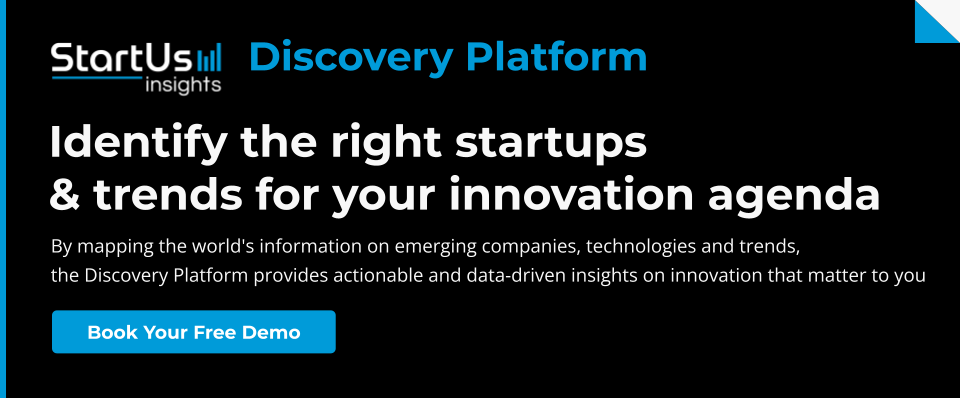
6. Wearable Technology
Wearables provide businesses with a wealth of personal data, including health metrics, location information, and even behavioral patterns. This data enables companies to tailor their services and marketing efforts with unprecedented precision. Moreover, wearables offer personalized recommendations, promotions, and services that match individual needs and preferences.
By monitoring customer activity data, businesses anticipate needs or issues before they arise, offering proactive support solutions. Wearable devices also streamline the process of accessing customer service. This further allows users to initiate contact or request assistance directly from their device, thereby reducing friction and enhancing satisfaction.
Palmplug develops Tracking and Haptic Feedback Systems
US-based startup Palmplug integrates hand tracking, haptic feedback, and visual cues to enhance human interaction. Its product suite includes TheraPlay, a stroke rehabilitation tool to guide patients through precise exercises, aiding in regaining mobility. Another product, Haptune, leverages haptic feedback for users to feel rhythms and melodies as they learn to play instruments.
Palmplug’s haptic feedback system simulates textures and vibrations, offering a tangible dimension to digital interactions, and enhancing gaming and training simulations. Visual cues are also delivered through vibrant LED lights, providing intuitive guidance and alerts in various applications, making interactions more engaging and user-friendly.
Kos improves Health Monitoring
US-based startup KOS offers BlueBerry, a wearable device that functions as an intelligent health-enhancing partner. It utilizes sensors, IoT, and AI to securely and rapidly process data. This enables healthcare providers, including hospitals and elderly care facilities, to quickly respond to health concerns.
BlueBerry creates a digital twin with a three-step process. It first collects data, which is then analyzed by its AI to extract vital health indicators and provide personalized recommendations. This approach covers various health aspects, including tailored dietary suggestions, rehabilitation support, and individualized sleep improvement advice.
A key component of the system is a voice-activated AI chatbot that functions as a virtual health advisor. This chatbot, continuously updated with medical data, tracks health metrics, provides customized advice, and assists with scheduling, ensuring a comprehensive health monitoring experience.
7. Customer Experience Management
Customer experience management platforms streamline the management of customer interactions across various touchpoints by employing strategies and technologies for comprehensive data collection and integration. They offer a unified customer view to enable personalized interactions through AI and analytics based on in-depth customer data.
Additionally, CXM solutions automate responses via chatbots for immediate engagement, utilize feedback for actionable insights, and map customer journeys to optimize experiences. They provide detailed performance analysis and ensure a seamless omnichannel experience, aligning technology with strategic business goals to improve customer satisfaction and drive growth.
CustomerScoops offers Real-Time Process Insights
Chile-based startup CustomerScoops develops three specialized platforms for lead experience management (LXM), CXM, and people experience management (PXM). Each platform is powered by AI and hyper-personalized with conversational UX/UI, making them adept at handling various aspects like (VoC) and Voice of the Employee (VoE) surveys.
CustomerScoops’ use of super algorithms and predictive models ensures that businesses leverage advanced analytics for strategic decision-making. Their Total Insights Dashboard provides a comprehensive overview of key metrics like net promoter score (NPS) and other vital insights, making it relevant for industries like health, automotive, airlines, finance, insurance, retail, e-commerce, and more.
Cliezen streamlines Insights Management
Iceland-based startup Cliezen offers a web interface that deploys dynamic feedback forms and provides management teams with deep insights into client desires and experiences. It uses an AI engine with several academically validated questions in marketing management, psychology, and business studies, adaptable to various industries and B2B relationships. This way, it automates the survey process and offers real-time insights while increasing customer loyalty.
Cliezen’s proprietary methodology includes comprehensive and continuous feedback beyond standard metrics like NPS. The platform also combines AI-driven communication assistance and CX task organization. Companies focused on client retention, satisfaction, and improved business performance find Cliezen platform useful.
8. Predictive Customer Analytics
Customer analytics targets and enables predictions about market trends, user behaviors, and campaign outcomes. It employs predictive modeling, data mining, and machine learning to integrate diverse data types like location, contextual, first-party, weather, real-time, and historical data. By understanding customer interaction with product features by tracking feature usage, clicks, hovers, and text inputs, businesses gain valuable insights.
Industries leveraging predictive customer analytics include retail, finance, healthcare, and e-commerce. For instance, in e-commerce, predictive analytics personalizes shopping experiences. It recommends products based on browsing history and purchase behavior, significantly boosting conversion rates. In healthcare, it improves patient care by predicting outcomes and personalizing treatment plans.
Graphite Note offers No-Code Predictive Analytics Platform
Ireland-based startup Graphite Note offers a no-code platform for AI-powered customer analytics. Users connect data sources like CSVs or databases, engaging with pre-built machine learning models. The platform features a variety of autoML models that enhance CRMs using Timeseries Forecast, Binary and Multi-Class Classification, Regression, CLV prediction, and more.
These tools assist in key CRM tasks like predicting customer churn, revenue forecasting, lead conversion, and product demand analysis. The platform also segments customers based on their recency, frequency, and monetary interactions.
Eiffo Analytics builds a Churn Prediction Model
French startup Eiffo Analytics builds Dasper, a data science as a service (DSaaS) platform that utilizes machine learning to predict customer churn from historical data. This platform allows for simple data upload and seamless integration into existing IT infrastructures, supporting real-time analysis and compatibility with many back-end systems.
Dasper accelerates customer behavior analysis, thereby enabling businesses to better understand and act on various stages of the customer life cycle. Its churn analysis capabilities identify at-risk customers and potential departures by generating personalized risk scores and the factors driving churn, enhancing customer retention strategies.
9. Customer Interaction
The chatbot industry and live chat AI-powered bots, particularly those using NLP and sentiment analysis, increasingly interpret conversations and user intent accurately. They enhance customer experience by integrating with systems like CRM and contact center as a service (CCaaS) across various domains like customer service and marketing.
AI-driven conversational UX also focuses on personalized content and guided conversations. Chatbots and live chat are evolving to recommend products, assist in grocery lists, and even provide voice-enabled interactions. This shift reduces costs, particularly in call centers, by automating routine tasks and improving employee efficiency. Businesses adopt such platforms for customer support, engagement, marketing, and sales automation.
Chative improves Customer Support Experience
Singapore-based startup Chative presents a solution to enhance sales engagement, retarget marketing, and customer support, tailored for small and medium businesses. The platform enhances customer interaction through its omnichannel live chat, streamlining communication across various channels into one central inbox. Chative boosts conversion rates by offering customizable chat windows and targeted messaging, paired with AI-driven chatbots for efficient outbound communication.
The platform also facilitates proactive customer support and seamless bot-human collaboration, catering to the evolving needs of cross-channel business messaging. Moreover, its messenger chat feature extends its reach, leveraging popular social media channels to drive sales and brand awareness.
Aunoa offers AI-Powered Customer Interactions
Spanish startup Aunoa‘s AI chatbot platform offers live chat and chatbot experiences across multiple sectors. Integrating AI-human hybrid technology with NLP pre-trained models, the chatbot enables personalized and efficient customer interactions. The platform’s robust multichannel capabilities allow seamless integration with CRM systems, automating FAQs and appointment scheduling.
The chatbot enables efficient service automation in utilities and enriches experiences in tourism. Its low-code operation and detailed AI chatbot analytics further optimize customer engagement, sales, and marketing while improving productivity and reducing response times.
10. Marketing Automation
Marketing automation enhances business engagement and streamlines processes, from lead acquisition to loyalty. It employs sophisticated CRM integrations and AI-driven chatbots for transition and engagement across the customer journey. Emerging companies leverage marketing automation tools to prioritize engaging leads nearing conversion and keeping in touch with current customers.
Once a lead converts, these automated systems send personalized welcome emails with relevant information. Through automation, gathering customer data such as purchase history, preferences, and behaviors also becomes streamlined, enabling targeted offers to promote repeat purchases.
Cronberry enables Comprehensive Marketing Automation
Indian startup Cronberry offers marketing automation and lead management software. This comprehensive software streamlines marketing effectiveness through personalized messaging and integrates leads from marketplaces. Its features include creating digital catalogs, developing no-code landing pages, and managing eCommerce operations.
The platform’s email marketing and notification systems optimize user engagement while the intuitive dashboard and user management tools provide real-time performance insights. Additionally, the software analyzes headings and email subjects, automates emails, and manages SMS, push, and in-app notifications. The software also integrates social media channels and various APIs, allowing businesses to personalize offers, track conversions, and engage leads effectively.
Vecton enhances Marketing Communication
Polish startup Vecton increases business growth through tailored marketing automation and communication strategies. With a focus on personalizing marketing across platforms, Vecton serves industries like clothing, household appliances, home decor, and retail. It offers comprehensive services in assessing the effectiveness of current activities and making optimal use of systems. The startup also provides ongoing support in maximizing the capabilities of marketing automation and CDP technologies.
Discover all Customer Experience Trends, Technologies & Startups
The trends highlighted in this report work together to forge a seamless personalized customer journey and mark a shift towards more engaging and data-driven interactions. Moreover, such an evolution sets a new standard in how businesses understand and connect with their customers, fostering loyalty and growth in the digital era.
The Customer Experience Trends & Startups outlined in this report only scratch the surface of trends that we identified during our data-driven innovation & startup scouting process. Identifying new opportunities & emerging technologies to implement into your business goes a long way in gaining a competitive advantage.
